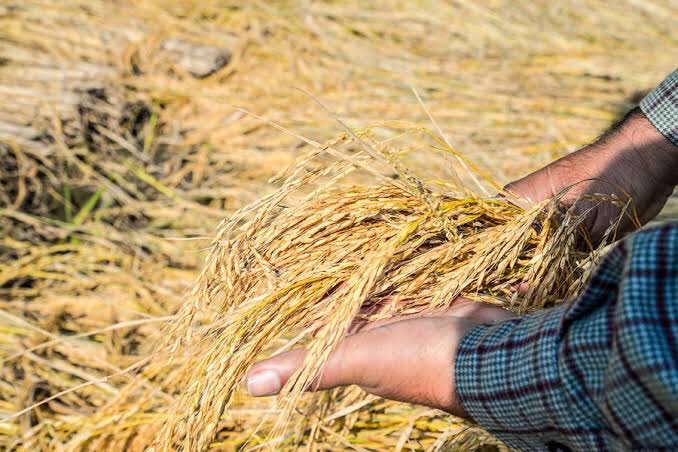
By Dr Vandana Shiva – Deccan Herald, 2 January 2021 | Source
We call rice ‘Akshat’ — the permanent, everlasting, unbroken, undamaged, whole. India is the centre of diversity of rice. From one wild grass Oryza Sativa, Indian peasants evolved 200,000 rice varieties that are nutrition-rich and climate-resilient. We grow black and red, purple and white rices, aromatic and therapeutic rices, drought-resistant, flood-resistant, salt-tolerant rice varieties that can help us face climate change.
‘Health’ is derived from the same origin as ‘whole’. Etymologically, it means ‘undamaged’ in the sense of uninjured, or not suffering from any illness. To heal is literally to ‘make whole’ again.
Health too is Akshat
We are facing pandemics like Covid-19, suffering from chronic diseases, and from malnutrition, because our food systems are broken, leading to damaged health and nutrition.
Our health is broken because we are using toxins in agriculture, we are growing monocultures to increase use of chemicals, we are destroying our biodiversity, which is the basis of health and nutrition.
Anaemia is widespread in India –58.6% of children, 53.2% of non-pregnant women and 50.4% of pregnant women were found to be anaemic in 2016, as per the NFHS. India carries the highest burden of the disease.
Anaemia, and other nutrient deficiencies in India, are a result of growing chemical monocultures that produce nutritionally-empty commodities at very high cost.
In a chemical and capital-intensive model of agriculture and food production, people are deprived of the right to produce and have access to wholesome food that is rich in nutrients.
Firstly, when rural communities spend money on costly chemicals, they join the ranks of the hungry. Half of the hungry people in the world today are farmers. Half of India’s hungry are farmers.
Secondly, the seeds bred through the Green Revolution model are bred for taking up more chemicals. Green Revolution varieties are called High-Yielding Varieties (HYV). This is a misnomer. As the UN pointed out in the 1970s, they are not high-yielding in and of themselves. They respond well to chemicals, and should more accurately be called ‘high-response varieties.’
The so-called modern varieties have low nutrition compared to native varieties. When measured in terms of nutrition, Green Revolution varieties are ‘low-yielding’ and native varieties are ‘high-yielding.’ A recent study carried out by scientists at Calicut University, Kerala, comparing 13 traditional varieties with two Green Revolution varieties showed that native varieties had 11% more protein compared to the so-called HYV. They had higher mineral content — zinc, manganese, potassium, calcium and iron.
Instead of measuring the weight of nutritionally-empty commodities and suffering the illusion that we are growing more food, we should replace yield per acre with the more appropriate measure of ‘nutrition per acre’ that Navdanya has adopted. We can feed two times India’s population with full nutrition if we grow our native varieties and intensify biodiversity, instead of chemicals.
Thirdly, chemical agriculture destroys nutrients in the soil, and hence in the plants that we eat. In industrialised countries, food has lost more than 60% of its nutrients due to industrial agriculture.
Navdanya’s research comparing changes in soil nutrients in chemical farms with organic farms over 20 years shows that chemical farms have lost upto 37.8% zinc, while the zinc content of organic soils increased by up to 14.3%. Chemical farms lost 12% iron, contributing to iron deficiency.
Fourthly, industrial processing is a system of removing nutrients from food and bringing us nutritionally-empty food, which contributes to malnutrition and metabolic disorders. Industrialists remove the bran from rice, and sell it as a high-value supplement, thus making money twice — once from selling white rice, and again from selling bran. While polished rice has only 0.7 mg of iron in 100 gm of rice, bran has 35 mg of iron. Hand-pounded rice has 2.8 mg of iron, and rice flakes have 20 mg.
To address malnutrition, we need to regenerate our native seeds which are high-yielding in terms of nutrition, practise chemical-free organic farming, and promote artisanal processing. We need to decolonise our food, agriculture and nutrition paradigm. We have a rich legacy of Ayurveda and organic farming which can inform us to address the crisis of malnutrition.
We have to avoid false solutions of biofortification like genetically-engineered ‘Golden rice’ or the proposed iron-fortified rice.
A recent article in The Print reported that “According to the government’s plan, rice will be extruded and then shaped into structures that resemble rice grains. The process of extrusion involves reforming rice flour into a pre-cooked product that can be shaped to resemble a rice grain. These kernels will then be fortified with micronutrients such as iron, folic acid and vitamin B-12 as planned and mixed with natural polished rice.”
It does not make scientific sense to remove nutrients from food through industrial breeding of seeds and production and processing of food, and then add one nutrient artificially as an “external input.”
We do not eat rice alone. We eat rice with dals and greens, which are rich in iron – amaranth, Bengal gram, turnip greens, cow pea leaves, mint, moringa leaves, asafoetida, mango powder, pipalli, and turmeric.
We are a biodiversity and knowledge-rich culture. Instead of spending Rs 2,500 crore per year distributing fake rice through the mid-day meal schemes and through the Public Distribution System (PDS), the government should spend that money to create community seed banks of indigenous Desi seeds, it should promote artisanal processing to increase nutrition in food while increasing employment, and it should promote organic farming for increasing nutrition in the soil and our food.
It is time to reclaim ‘Akshat,’ our unbroken scientific and cultural heritage of food, health and nutrition. Ayurveda teaches us “Annam Sarvaushdhi.”
Growing biodiversity for health and nutrition is true Atmanirbharta.
